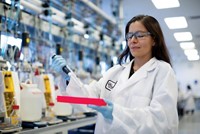Advertisement
Grab your lab coat. Let's get started
Welcome!
Welcome!
Create an account below to get 6 C&EN articles per month, receive newsletters and more - all free.
It seems this is your first time logging in online. Please enter the following information to continue.
As an ACS member you automatically get access to this site. All we need is few more details to create your reading experience.
Not you? Sign in with a different account.
Not you? Sign in with a different account.
ERROR 1
ERROR 1
ERROR 2
ERROR 2
ERROR 2
ERROR 2
ERROR 2
Password and Confirm password must match.
If you have an ACS member number, please enter it here so we can link this account to your membership. (optional)
ERROR 2
ACS values your privacy. By submitting your information, you are gaining access to C&EN and subscribing to our weekly newsletter. We use the information you provide to make your reading experience better, and we will never sell your data to third party members.
Environment
Presidential Awards
Honors recognize smarter chemistry that promotes pollution prevention
by Stephen K. Ritter
July 5, 2004
| A version of this story appeared in
Volume 82, Issue 27

The ninth annual Presidential Green Chemistry Challenge Awards were presented to four companies and a pair of individuals during a ceremony held on June 28 at the National Academy of Sciences in Washington, D.C. Administered by EPA's Office of Pollution Prevention & Toxics, the awards program is a competitive effort to recognize superlative chemical products and processes that help achieve federal pollution-prevention goals.
American Chemical Society President Charles P. Casey, speaking at the ceremony, commented that one of the challenges the chemical profession faces is making the connections between chemistry and daily living. This year's winners do just that with their impact on everyday consumer products, such as pharmaceuticals, paper, detergents, and plastics, he said. "Green chemistry is making a real difference in our science and engineering and is making major societal contributions in the U.S. and around the world."
The 2004 award recipients and their winning technologies are as follows:
◾ Chemical engineering professor Charles A. Eckert and chemistry professor Charles L. Liotta of Georgia Institute of Technology received the academic award for developing "environmentally benign" supercritical CO2, near-critical water, and CO2-expanded fluid systems that can be used as replacement solvents in a variety of chemical reactions and separations.
◾ Jeneil Biosurfactant Co. was presented the small-business award for developing a commercial-scale fermentation process to make rhamnolipid biosurfactants—a rhamnose sugar ring with a fatty acid tail—that are low-toxicity alternatives to petroleum-derived surfactants.
◾ Bristol-Myers Squibb was recognized in the alternative synthetic pathways category for replacing its semisynthetic route to the anticancer drug Taxol (paclitaxel) with a more sustainable plant-cell fermentation technology.
◾ Buckman Laboratories International was honored with the award for alternative reaction conditions for developing its Optimyze enzyme formulation to replace organic solvents used to clean accumulation of sticky materials on equipment during paper recycling.
◾ Engelhard Corp. received the award in the designing safer chemicals category for its Rightfit azo pigments that are replacements for heavy-metal-based inorganic pigments used to color plastic containers for consumer products.
Susan B. Hazen, principal deputy assistant administrator of EPA’s Office of Prevention, Pesticides & Toxic Substances, commented that the results of the Green Chemistry Challenge program “have been absolutely incredible.” To date, the 41 previous award-winning technologies are preventing the generation of more than 137 million lb per year of hazardous materials and wastes from almost every sector of the chemical industry, she said.





Join the conversation
Contact the reporter
Submit a Letter to the Editor for publication
Engage with us on Twitter